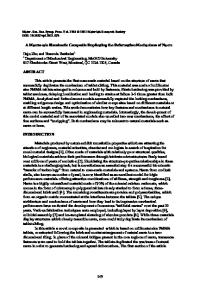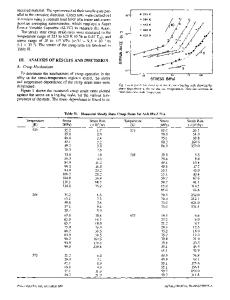Interaction of high-temperature deformation mechanisms
- PDF / 2,328,247 Bytes
- 6 Pages / 597 x 774 pts Page_size
- 88 Downloads / 336 Views
I.
INTRODUCTION
SUPERPLASTICITY (SP) of metallic materials requires a fine-grained structure (usually on the order of less than 10/zm) and deformation temperatures higher than 0.5Tin (Tin is the absolute melting point). [~,2,3] However, the grain structure of commercial superplastic materials is usually nonuniform. The inhomogeneity of grain structure can be (1) of the scale of specimen dimensions, e.g., laminated composites, and (2) in the range of grain size, e.g., bands of fine and coarse grains, clusters of fine and coarse grains. It has been reported that regions of fine and coarse grains coexist, and the distributions of the grain size may change during superplastic deformation, t41 However, it is difficult to describe the deformation behavior of such materials, although the deformation characteristics of materials with either finegrained structure or coarse-grained structure have been well studied. [1-3,5,61 In this study, the deformation behavior of a magnesium alloy with randomly mixed fine- and coarse-grained structure was experimentally investigated and theoretically modeled. Besides the commercial significance of superplastically forming structural components, such an investigation is also important from the viewpoint of the interaction of deformation mechanisms operative within the fine- and coarse-grained regions.
II.
EXPERIMENTAL PROCEDURE
A magnesium alloy with a composition of Mg-1.5 pct Mn-0.3 pct Ce (in weight percent) was used for this investigation. In the first step of specimen preparation, a fine-grained structure with a grain size of 10 --- 1.5/xm was produced by cold rolling, with a thickness reduction M.G. ZELIN, Postdoctoral Research Fellow, formerly Associate Professor with the Ufa Aviation Institute, H.S. YANG, Postdoctoral Research Fellow, and A.K. MUKHERJEE, Professor, are with the Department of Mechanical, Aeronautical and Materials Engineering, University of California-Davis, Davis, CA 95616-5294. R.Z. VALIEV, Professor, is with the Ufa Aviation Institute, Ufa 450025, Russia. Manuscript submitted April 20, 1992. METALLURGICAL TRANSACTIONS A
of 20 pct and subsequent annealing at 670 K for 40 minutes. Such fine-grained material showed SP at 670 K and a strain rate of 4 x 10 -4 S-1. [7] The 100 pct coarse-grained structure with a grain size of 100 -+ 8 ftm could be obtained by cold prestraining a tensile specimen with the fine-grained structure up to a critical recrystallization strain of 3 pct [sj and sequential annealing at 670 K for 40 minutes. The specimens tested in this investigation had a randomly mixed fine- and coarse-grained structure with varying volume fractions of the coarse grains (Vcg/V = 0.0 to 1.0). This type of structure was produced by cold prestraining of the fine-grained material ( - 1 0 / z m ) up to 1.8 to 3 pct elongation and subsequent annealing at 670 K for 40 minutes. The higher the prestrain (up to 3 pct), the higher was the volume fraction of the coarse grains. Mechanical tests were conducted on an Instron machine under conditions which are optimal fo
Data Loading...











